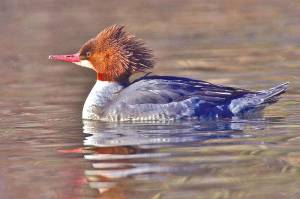Signs of Winter
 Living here in the north, we look forward to events in the natural world that signal the change of season. One of the events I look forward to in December is the arrival of the common mergansers. These birds move south every year just ahead of the ice that covers their northern lakes, and their arrival is a sign that our lake will soon freeze.
Living here in the north, we look forward to events in the natural world that signal the change of season. One of the events I look forward to in December is the arrival of the common mergansers. These birds move south every year just ahead of the ice that covers their northern lakes, and their arrival is a sign that our lake will soon freeze.
This morning, we were up before the sun. According to the clock, it was not particularly early, but the sky was still black and stars shone brightly. The thought crossed my mind that if it were June instead of December I would be out on the lake in my kayak at this same hour and the sun would already be high in the sky. But it is not June, it is December, and these days the sun rises so late many folks are up and about before sunrise. We sat by the living room window, holding steaming mugs of tea and looking out toward the dark lake. Gradually, it became less dark outside, and we began to notice a dull look to the surface of the cove. As the sky continued to lighten, we discovered there was a skin of ice on the water.
After the sun came up over the eastern hill, I walked down to the lake and looked at the new ice, which was streaked with fine lines and delicate ridges. Out beyond the cove, where the open water had turned a deep blue in the sunlight, a pair of hooded mergansers drifted and fished. A dozen mallards swam into the cove, but when they reached the edge of the ice they turned and swam back up the lake.
I went back up to the house to make my breakfast, but I kept glancing out the windows toward the lake hoping other birds might show up. Just as I poured milk over my bowl of cereal and fruit, a large flock of white birds appeared, swimming in a long straight line down the middle of the lake. They were common mergansers. I left the bowl of cereal on the counter, set up the spotting scope, and watched the straight line dissolve as the mergansers began to mill around, socializing and diving.
There are three species of mergansers in Maine. The hooded merganser, the smallest, visits our lake during spring and fall migration, and can be seen around here in winter in places where there is open water. The red-breasted merganser is typically found on brackish or salt water, and is not usually seen around this area. The common merganser is the largest of the three species, and in the early days of winter large flocks of them gather on our lakes, on their way to the open water along the coast. From a distance they look large, and since they ride low in the water folks occasionally mistake them for loons, even though they are much smaller than loons. At this time of year, loons are gray with a white breast, while male common mergansers are bright white with a dark back, and dark head and neck. Females are gray, with a white breast, with a reddish head and a distinctive crest. On both male and female common mergansers, there is a cleanly defined line where the dark head and white body meet. In summer, common mergansers are found near fresh water in northern Maine and all across Canada. They nest in tree cavities excavated by large woodpeckers, or where a limb has broken off. Their diet consists of a wide variety of food items, including small fish, insects, mollusks, worms, frogs, small mammals, birds and plants.
The flock of common mergansers on our lake this morning gradually reassembled into a line, and as they swam down the lake I counted 60 of them, although I suspect there were a few more than that. By the time the flock swam out of sight, I realized my cereal was quite soggy, a small price to pay for being able to witness one of the important events of the natural year, a signal of the approaching winter.
Jean Preis is a resident of Bridgton.


